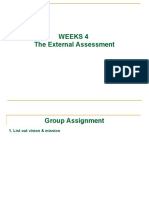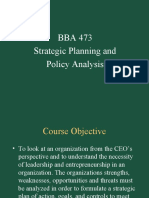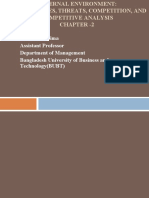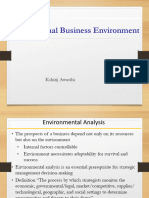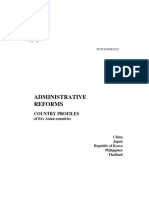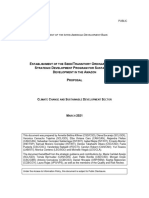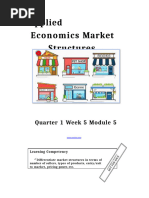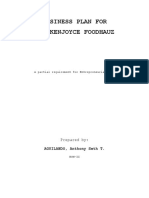BAGB3013 - Lesson 2
BAGB3013 - Lesson 2
Uploaded by
rangedaCopyright:
Available Formats
BAGB3013 - Lesson 2
BAGB3013 - Lesson 2
Uploaded by
rangedaOriginal Title
Copyright
Available Formats
Share this document
Did you find this document useful?
Is this content inappropriate?
Copyright:
Available Formats
BAGB3013 - Lesson 2
BAGB3013 - Lesson 2
Uploaded by
rangedaCopyright:
Available Formats
Lesson 2 TOPIC: External Assessment
• External Strategic Management Audit
• Industrial Organisation (I/O) View
• Economic Forces
• Social, Cultural, Demographic and
Environmental Forces
• Political, Government and Legal Forces
• Technological Forces
• Competitive Forces
• Five-Forces Model of Competition
• The Global Challenge
• Industry Analysis
Why This Lesson
Organisations do not exist in a vacuum, isolated from other beings. Being part of a society, an industry, and a
country or the world at large makes an organisation vulnerable to changes that happen in its external
environment. The current COVID-19 pandemic is a perfect example of how businesses are affected by their
external environment. To glove makers like Top Glove, the pandemic is a blessing in disguise which pushes their
revenue and share price beyond their expectations. To AirAsia and other airlines, the pandemic is a nightmare
that they are not able to erase. This topic discusses at length what constitutes the external environment of an
organisation and how the changes in the environment can become opportunities or will they threaten the
organisation.
External Strategic Management Audit
Audit in external management strategies checks the company’s economic assumptions and compares them to
actual values. There are two tools used:
• Environmental Scanning
• Industry Analysis
Both of these tools help to identify and evaluate factors beyond the control of a firm. Those factors are:
• Increased foreign competition
• Population shift
• Aging society
• Stock market volatility
• Fear of traveling
The purpose of the audit is to identify opportunities and threats. Its key external forces are:
• Economic forces
• Social, cultural, demographic and environmental forces
• Political, governmental and legal forces
• Technological forces
• Competitive forces
© UNITAR International University 1
The diagram below shows how the key external forces are transferred in the external audit.
Competitors
Suppliers
Distributors
Creditors
Customers
Employees
Communities
Managers Opportunities &
Key External Forces
Stockholders Threats
Labor Unions
Special Interest
Groups
Products
Services
Markets
Natural Environment
The external key factors are gathered through competitive intelligence from these categories:
• Social
• Cultural
• Demographic
• Environmental
• Governmental
• Legal
• Technological
Its source of information comes from:
• Internet
• Libraries
• Suppliers
• Distributors
• Salespersons
• Customers
• Competition
When performing an external audit there are variables to consider:
• Market share
• Breadth of competing products
• World economics
• Foreign affiliates
• Proprietary account advantages
• Price competitiveness
© UNITAR International University 2
• Technological advancements
• Interest rates
• Pollution abatement
In summary, the performing external audit can be seen in the diagram below.
Long-term orientation
Measurable
External
Factors
Applicable to competing firms
Hierarchical
Industrial Organisation (I/O) View
Industrial Organisation (I/O) view refers to how the industry factor is more important than the internal factor. The
performance is determined by the industry forces.
Industry Properties
• Economies of Scale
• Barriers to market entry
• Product differentiation
• Level of competitiveness
Economic Forces
Economic forces refer to the nature and direction of the economy in which the business operates and how it
impacts the firms.
Economic forces are applied to:
• Trends in the dollar’s value
• European Union
• Layoffs
• Economic standard of living
© UNITAR International University 3
They are also used to measure the:
• Availability of credit
• Level of disposable income
• Interest rates
• Inflation rates
Social, Cultural, Demographic and Environmental Forces
Social, cultural, demographic and environmental forces focus on the norms and values of the society in which a
business operates. They can create many opportunities for a business to thrive. The major impacts are toward:
• Products
• Services
• Markets
• Customers
They can be applied to the present through trends such as:
• Educated consumers
• Aging population
• Local rather than federal solutions
The key variables for the four forces are:
• Childbearing rates
• Number of special interest groups
• Number of marriages and divorces
• Number of births and deaths
• Immigration and emigration rates
However, the monitored variables that use these forces are:
• Actuarial rates
• Per capita income
• Attitudes toward business
• Average disposable income
• Consumer behaviour
• Ethical concerns
• Attitudes toward saving
• Racial equality
• Average educational level
• Governmental regulation
• Attitudes toward customer service
• Attitudes toward quality
• Energy conservation
• Social responsibility
• Leisure time values
• Recycling
• Waste management
• Air and water pollution
• Ozone depletion
• Endangered species
© UNITAR International University 4
Political, Government, and Legal Forces
Political, government and legal forces focus on the decisions made by various commissions and agencies, as
well as presenting potential restrictions on how an organisation operates. There are 3 points that will be discussed
in this section.
Government Regulation
These are rules that define the bounds of legal behaviour. They focused on key opportunities and threats to the
business such as:
• Anti-trust legislation
• Tax rates
• Lobbying efforts
• Patent laws
Increasing Global Interdependence
Global interdependence refers to worldwide mutual dependence between countries. The political variables
impact on:
• Formulation of strategies
• Implementation of strategies
Strategists that work in the global economy focused on:
• Forecast political climates
• Legalistic skills
• Diverse world cultures
Globalisation of Industry
A process linked by interconnected cross-border production and it enables firms to enter into new markets. It
focuses on:
• Worldwide trend toward similar consumption patterns
• Global buyers and sellers
• E-commerce
• Technology for instant currency transfers
In terms of key variables, they are:
• Regulation/deregulation
• Tax law changes
• Special tariffs
• Voter participation rates
• Number of patents
• Environmental protection laws
• Equal employment legislation
• Government subsidies
• Anti-trust enforcement
• Global relationships
• Import/export regulations
• Political conditions
• Location and severity of terrorist activity
© UNITAR International University 5
Technological Forces
Technological forces refer to the developments in technology that have on consumers, businesses, and society.
It causes a major impact on the:
• Internet
• Communications
• Semiconductors
The impacts are done by both the Chief Information Officer (CIO) and Chief Technological Officer (CTO) in the
IT department.
• CIO oversees the people, processes and technologies within a company’s IT organisation.
• CTO is in charge of an organisation’s technological needs as well as its research and development.
Technological forces have experienced technology-based issues. The issues are related to any essentials that are
required in every strategic decision.
Competitive Forces
Competitive forces are factors and variables that threaten a company’s profitability and prevent its growth. They
collect and evaluate data on competitors that are important for a successful strategy formulation. The
competition is intense in all industries.
To collect and evaluate data, competitive forces must identify the rival firm’s:
• Strengths
• Weaknesses
• Capabilities
• Opportunities
• Threats
• Objectives
• Strategies
When concerning competitors, the key questions must focus on:
• Their strengths
• Their weaknesses
• Their objectives and strategies
• Their responses to external variables
• Their vulnerability to our alternative strategies
• Our vulnerability to strategic counterattack
• Our product/service positioning
• Entry and exit of firms in the industry
• Key factors for our current position in the industry
• Sales/profit rankings of competitors over time
• Nature of supplier and distributor relationships
• Threat of substitute products/services
• Keeping the strategies a secret from employees and stakeholders
Competitive forces gained their corporate information from the following sources:
© UNITAR International University 6
• Moody’s Manuals
• Standard Corporation Descriptions
• Value Line Investment Surveys
• Dun’s Business Rankings
• Standard and Poor’s Industry Surveys
• Industry Week
• Forbes, Fortune, Business Week
The United States has the most competitive firms. There are 7 characteristics of how the firms are successful:
1. Market share matters
2. Understand what business you are in
3. Broke or not, fix it
4. Innovate or evaporate
5. Acquisition is essential to growth
6. People make a difference
7. No substitute for quality
Five-Forces Model of Competition
Potential
development of
substitute
products
Bargaining Bargaining
Rivalry among power of
power of competing firms
suppliers consumers
Potential entry of
new competitors
Rivalry among competing firms:
• Most powerful of the five forces
• Focus on the competitive advantage of strategies
Potential entry of new competitors
• Barriers to entry are important
• Quality, pricing, and marketing can overcome barriers
© UNITAR International University 7
Potential development of substitute products:
• Pressures increase when consumer’s switching costs decrease
• Firm’s plans for increased capacity and market penetration
Bargaining power of suppliers:
• Large number of suppliers and few substitutes affect the intensity of the competition
• Backward integration can gain control or ownership of suppliers
Bargaining power of consumers:
• Customers concentrated or buying in volume affects the intensity of competition
• Consumer power is higher where products are standard or undifferentiated
When the consumer gains bargaining power, there are several conditions to consider:
• If they can inexpensively switch
• If they are particularly important
• If sellers are struggling in the face of falling consumer demand
• If they are informed about the seller’s products, prices and costs
• If they have discretion in whether and when they purchase the product
In order to determine how an acceptable profit can be earned, the following steps are:
1. Identify key aspects or elements of each competitive force
2. Evaluate how strong and important each element is for the firm
3. Decide whether the collective strength of the elements is worth the firm entering or staying in the industry
The competition also uses forecasts to predict future trends and events. It uses 2 types of techniques:
• Quantitative technique (when historical data is available and there is a constant relationship)
• Qualitative technique
The Global Challenge
There are 3 factors that cause global challenges in strategic management.
1. Multinational Corporation (MNC’s) - which is globally competitive and naturally responsive.
2. Globalisation – worldwide integration of:
a. strategy formulation
b. strategy implementation
c. strategy evaluation
3. Globalisation of industries – has similar consumption patterns. Seen in global buyers and sellers such as e-
commerce and instant transmission of money and information.
Industry Analysis
Industry analysis is a method that helps to understand a company’s position relative to other participants in the
industry.
It uses the External Factor Evaluation (EFE) matrix, a tool used to evaluate the firm’s external environment and its
strengths and weaknesses.
© UNITAR International University 8
Another matrix is the Competitive Profile Matrix (CFM), which identifies the firm’s major competitors and their
strengths and weaknesses in relation to firm’s strategic position.
- end of content –
© UNITAR International University 9
You might also like
- Chapter 3 External AssessmentDocument91 pagesChapter 3 External Assessmentgjzbqq9fzwNo ratings yet
- The External AuditDocument19 pagesThe External AuditAngelica P. CoracheaNo ratings yet
- Course Title: Strategic Management Unit 3 Environmental Analysis Course LeaderDocument64 pagesCourse Title: Strategic Management Unit 3 Environmental Analysis Course LeaderadwdadadNo ratings yet
- Environments: Environmental ScanningDocument30 pagesEnvironments: Environmental ScanningVikyath Ajjampur ShetruNo ratings yet
- Topic 3: The External EnvironmentDocument52 pagesTopic 3: The External EnvironmentFajri Yudha PratamaNo ratings yet
- PESTLE Analysis SystemDocument35 pagesPESTLE Analysis SystemTejas DangodraNo ratings yet
- External AnalysisDocument6 pagesExternal AnalysisJawad Ahmad100% (1)
- CHAPTER 2 The External AssessmentDocument51 pagesCHAPTER 2 The External AssessmentAbdul MuizNo ratings yet
- Topic-03 (External Environment)Document52 pagesTopic-03 (External Environment)Fadhilah HazimahNo ratings yet
- Strategic Management CH-4Document33 pagesStrategic Management CH-4fuad abduNo ratings yet
- Retail Environment 2Document27 pagesRetail Environment 2Retail Fashion MerchandisingNo ratings yet
- Strama Chapter 3Document14 pagesStrama Chapter 3CIARA MAE ORTIZNo ratings yet
- Weeks 4 The External AssessmentDocument41 pagesWeeks 4 The External AssessmentRara Sakti Yuwanda PutriNo ratings yet
- The External Environment AssessmentDocument70 pagesThe External Environment AssessmentSamuel ChandalaNo ratings yet
- Corporate Environmental Scanning: Internal Corporate Environment External Corporate EnvironmentDocument43 pagesCorporate Environmental Scanning: Internal Corporate Environment External Corporate EnvironmentKrysya EnrqzNo ratings yet
- ADM650 CHAPTER 2 External AnalysisDocument58 pagesADM650 CHAPTER 2 External AnalysisArya zllkaNo ratings yet
- Mba - Financial ManagrmentDocument44 pagesMba - Financial ManagrmentJimmy JamesNo ratings yet
- Environmental Scanning and Industry Analysis: Unit IIDocument41 pagesEnvironmental Scanning and Industry Analysis: Unit IIhimanshuNo ratings yet
- Manajemen Stratejik PPT 3Document8 pagesManajemen Stratejik PPT 3Aaron jonathanNo ratings yet
- Business Environment Unit-1Document36 pagesBusiness Environment Unit-1Ayush LohiyaNo ratings yet
- Module 2.PptxDocument22 pagesModule 2.PptxPranav JagdaleNo ratings yet
- Intorduction To MM Module 01 MmU2 - 1Document26 pagesIntorduction To MM Module 01 MmU2 - 1Harsh PatelNo ratings yet
- Presentation On: Chapter - 3Document54 pagesPresentation On: Chapter - 3rajvee18No ratings yet
- APPLIED-ECONOMICS Q2 Module-1 Business-EnvironmentDocument14 pagesAPPLIED-ECONOMICS Q2 Module-1 Business-EnvironmentFRANCE ARLENE BOISONNo ratings yet
- External Environmental AnalysisDocument94 pagesExternal Environmental Analysissrizana basnetNo ratings yet
- 6 - The External Assessment - PDFDocument15 pages6 - The External Assessment - PDFAzman ArifNo ratings yet
- SM All in OneDocument230 pagesSM All in OneniharaNo ratings yet
- Chapter 02 & 3Document29 pagesChapter 02 & 3Shoukat Ali100% (1)
- Business Environment PPT 2020 PDFDocument50 pagesBusiness Environment PPT 2020 PDFSatyam AgarwallaNo ratings yet
- MGT 108 Chapter 3Document30 pagesMGT 108 Chapter 3Ella CunananNo ratings yet
- Environmental Analysis 3 (8-10M)Document72 pagesEnvironmental Analysis 3 (8-10M)Sania KhanNo ratings yet
- Environment Analysis & DiagnosisDocument75 pagesEnvironment Analysis & Diagnosissamu5614100% (3)
- External Analysis: Strategic ManagementDocument28 pagesExternal Analysis: Strategic ManagementMUDDASIR AHAMED KHAN N AI002522No ratings yet
- Ppt. Group 3Document55 pagesPpt. Group 3wjc5tfv8mbNo ratings yet
- Chapter 3 - The External AssessmentDocument37 pagesChapter 3 - The External Assessmentsaya siapa?No ratings yet
- Analyzing Company's External EnvironmentDocument58 pagesAnalyzing Company's External EnvironmentSharath KannanNo ratings yet
- Lecture 3 2002Document33 pagesLecture 3 2002Saul HernandezNo ratings yet
- Chapter Two The Business EnvironmentDocument57 pagesChapter Two The Business EnvironmentBinyam TesfamariamNo ratings yet
- Topic 3 - External AssesmentDocument32 pagesTopic 3 - External AssesmentMarcoMárquezFidalgoNo ratings yet
- SM-Mod-2-2022Document129 pagesSM-Mod-2-2022Kusuma KusumaNo ratings yet
- CH 3 - SMDocument47 pagesCH 3 - SMElias HaileNo ratings yet
- BE Unit 1&2 ChatGPTDocument27 pagesBE Unit 1&2 ChatGPTskofficial721No ratings yet
- Business EnvironmentDocument49 pagesBusiness EnvironmentavpiqacNo ratings yet
- Chapter 3 - The External Assessment: By: Justice PajarilloDocument26 pagesChapter 3 - The External Assessment: By: Justice PajarillojohnNo ratings yet
- SM-Module-3 (1)Document44 pagesSM-Module-3 (1)inaaralalani22No ratings yet
- Chapter 2 - The External and Internal Assessment - SVDocument76 pagesChapter 2 - The External and Internal Assessment - SV8.Nguyễn Việt HoàngNo ratings yet
- Nasrin Shamima Assistant Professor Department of Management Bangladesh University of Business and Technology (BUBT)Document56 pagesNasrin Shamima Assistant Professor Department of Management Bangladesh University of Business and Technology (BUBT)Mihal As-Samah 070No ratings yet
- Chapter Two Environment and Resource AnalysisDocument47 pagesChapter Two Environment and Resource AnalysisSehabom GeberhiwotNo ratings yet
- Ch03 - Organizational Environments and CulturesDocument59 pagesCh03 - Organizational Environments and CulturesRishikalpa BhattacharyaNo ratings yet
- Business Environment M. Com 2 ND SemDocument30 pagesBusiness Environment M. Com 2 ND SemAntas KumarNo ratings yet
- MGB Session 3-4Document67 pagesMGB Session 3-4Krishna DeepaNo ratings yet
- CH 2 MarketingDocument69 pagesCH 2 MarketingamogneNo ratings yet
- Unit 2 - Environmental AnalysisDocument79 pagesUnit 2 - Environmental Analysisnikhila saiNo ratings yet
- 3 External EnvironmentDocument17 pages3 External EnvironmentSakif Tasawer Sonto (173014038)No ratings yet
- Chapter 3Document31 pagesChapter 3እማሸንኮሮ በአማራNo ratings yet
- External Analysis: - Industry Structure - Competitive Forces - Strategic GroupsDocument36 pagesExternal Analysis: - Industry Structure - Competitive Forces - Strategic GroupsgabiNo ratings yet
- Topic 3 External AnalysisDocument52 pagesTopic 3 External Analysis黄洁宣No ratings yet
- Lec 2 Environment & Corp - CultDocument42 pagesLec 2 Environment & Corp - CultRana YassinNo ratings yet
- Chap 03Document61 pagesChap 03Mariam shahzadiNo ratings yet
- Lesson 6Document7 pagesLesson 6rangedaNo ratings yet
- Lesson 5Document4 pagesLesson 5rangedaNo ratings yet
- Lesson 3Document4 pagesLesson 3rangedaNo ratings yet
- Bagb2033 Corporate Social Policy Final Report by Group 2Document16 pagesBagb2033 Corporate Social Policy Final Report by Group 2rangedaNo ratings yet
- Assignment LegendaryEntertainmentDocument3 pagesAssignment LegendaryEntertainmentrangedaNo ratings yet
- Topic Review 3Document3 pagesTopic Review 3rangedaNo ratings yet
- FMCG Sector: Prepared By: Nimika Prachi Prerna Renu Santosh ShilpaDocument22 pagesFMCG Sector: Prepared By: Nimika Prachi Prerna Renu Santosh ShilpaDashing NickNo ratings yet
- 1st CCI PU Moot RulesDocument19 pages1st CCI PU Moot RulesSHIVAM SHARMANo ratings yet
- Micro Economics IIDocument237 pagesMicro Economics IImillionyohannis.studNo ratings yet
- Chapter 16-Monopolistic Competition-Đã M KhóaDocument8 pagesChapter 16-Monopolistic Competition-Đã M Khóaminhhuynh.31241027282No ratings yet
- The External Environment: Hitt - Chapter 2Document27 pagesThe External Environment: Hitt - Chapter 2Murgi kun :3No ratings yet
- Mohammed ThalhaDocument54 pagesMohammed Thalhaakashgak45No ratings yet
- Reference 1997-Administrative-Reforms - Country-Profiles-of-Five-Asian-CountriesDocument155 pagesReference 1997-Administrative-Reforms - Country-Profiles-of-Five-Asian-Countries0858redzNo ratings yet
- Price DiscriminationDocument4 pagesPrice Discriminationujjaini870No ratings yet
- Bank Market PowerDocument18 pagesBank Market PowerWahyutri IndonesiaNo ratings yet
- Proposal For The Establishment of The Seed-Transitory Ordinary Capital Strategic Development Program For Sustainable Development in The Amazon.Document29 pagesProposal For The Establishment of The Seed-Transitory Ordinary Capital Strategic Development Program For Sustainable Development in The Amazon.M. Cesia Flores BazanNo ratings yet
- Anderson - 2017 - Factors Affecting Small & Medium Enterprises (SMEs) Start-Up and Growth in TanzaniaDocument26 pagesAnderson - 2017 - Factors Affecting Small & Medium Enterprises (SMEs) Start-Up and Growth in TanzaniawynfredNo ratings yet
- CH 13Document55 pagesCH 13Bobby513No ratings yet
- The Geography of SerbiaDocument8 pagesThe Geography of SerbiaIulia JulieNo ratings yet
- Tourism in AzerbaijanDocument36 pagesTourism in AzerbaijanGuler BabeliyevaNo ratings yet
- IER Assignment 1Document6 pagesIER Assignment 1biegatkuoth4No ratings yet
- ALSabm Applied Economics 12 q1 w5 Mod5 Market StructureDocument17 pagesALSabm Applied Economics 12 q1 w5 Mod5 Market StructureKylavigne MalanNo ratings yet
- Anti-Competitive AgreementsDocument25 pagesAnti-Competitive AgreementsMa FajardoNo ratings yet
- Business Plan For Chickenjoyce Foodhauz: AGUILANDO, Anthony Seth TDocument23 pagesBusiness Plan For Chickenjoyce Foodhauz: AGUILANDO, Anthony Seth TAnthony Seth AguilandoNo ratings yet
- First Solar: Student Name: Student IdDocument25 pagesFirst Solar: Student Name: Student IdUzma SiddiquiNo ratings yet
- MGT490 - Group AssignmentDocument37 pagesMGT490 - Group AssignmentZulkarnain SeamNo ratings yet
- Effects of Strategic Planning On Organizational Productivity of Fiber Home Phils Inc.Document12 pagesEffects of Strategic Planning On Organizational Productivity of Fiber Home Phils Inc.International Journal of Innovative Science and Research TechnologyNo ratings yet
- Impact of Strategic Vigilance and Crisis Management On Business Continuity ManagementDocument16 pagesImpact of Strategic Vigilance and Crisis Management On Business Continuity ManagementThe way to heavNo ratings yet
- PCP Diagnostics Ivory Coast EnglishDocument156 pagesPCP Diagnostics Ivory Coast EnglishLemon BOINo ratings yet
- A Bookshop Business PlanDocument33 pagesA Bookshop Business Planomulubiirene100% (1)
- Ipr 1948-1990Document10 pagesIpr 1948-1990Vijaykumar EttiyagounderNo ratings yet
- Lower Athabasca Regional Plan: Implementation Progress Report For 2020 and 2021Document24 pagesLower Athabasca Regional Plan: Implementation Progress Report For 2020 and 2021abdulloh aqilNo ratings yet
- Gearing Up For The Future of Manufacturing in BangladeshDocument90 pagesGearing Up For The Future of Manufacturing in BangladeshjamilkhannNo ratings yet
- Monopoly vs. Monopolistic CompetitionDocument2 pagesMonopoly vs. Monopolistic CompetitionJenniferNo ratings yet
- Industrial Product-Service Systems (IPS2) Paradigm Shift by Mutually Determined Products and ServicesDocument17 pagesIndustrial Product-Service Systems (IPS2) Paradigm Shift by Mutually Determined Products and ServicesVinicius SoaresNo ratings yet
- PepperDocument14 pagesPepperYudi SaputraNo ratings yet












